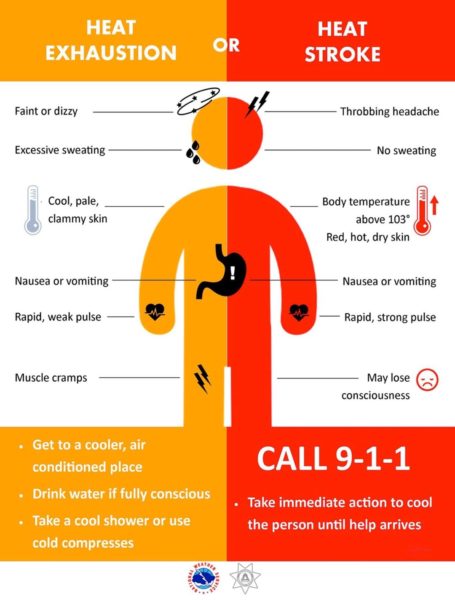Here’s what truckers need to know about heat cramps, heat exhaustion, and heat stroke

As temperatures rise during the summer, truckers are often exposed to dangerously hot conditions that can lead to heat-related illnesses — here’s what you need to know to protect your health in sweltering weather.
As temperatures climb into the 90s or triple digits, so does the risk to truck drivers of contracting heat related illness. Many truck drivers are lucky enough to have access to air conditioning in their vehicles while idling or using the APU, but some drivers end up sweating it out if they don’t have an APU or are in an area with strict idling rules. Some drivers are forced to park overnight in areas that aren’t safe and are afraid to even crack a window to let in a breeze.
Excessive heat can even have deadly consequences for drivers out on the road. In the summer of 2020, a 62 year old driver and his dog were found deceased in a hot truck at a truck stop in Barstow, California.
Here’s a quick rundown from the National Weather Service of the symptoms and recommended treatment for different heat-related illness that all truckers should know.
Heat Cramps
Heat cramps may be the first sign of heat-related illness, and may lead to heat exhaustion or stroke.
- Symptoms: Painful muscle cramps and spasms usually in legs and abdomen and Heavy sweating.
- First Aid: Apply firm pressure on cramping muscles or gently massage to relieve spasm. Give sips of water unless the person complains of nausea, then stop giving water.
Seek immediate medical attention if cramps last longer than 1 hour.
Heat Exhaustion
- Symptoms: Heavy sweating, Weakness or tiredness, cool, pale, clammy skin; fast, weak pulse, muscle cramps, dizziness, nausea or vomiting, headache, fainting,
- First Aid: Move person to a cooler environment, preferably a well air conditioned room. Loosen clothing. Apply cool, wet cloths or have person sit in a cool bath. Offer sips of water. If person vomits more than once,
Seek immediate medical attention if the person vomits, symptoms worsen or last longer than 1 hour
Heat Stroke
- Symptoms: Throbbing headache, confusion, nausea, dizziness, body temperature above 103°F, hot, red, dry or damp skin, rapid and strong pulse, fainting, loss of consciousness.
- First Aid: Call 911 or get the victim to a hospital immediately. Heat stroke is a severe medical emergency. Delay can be fatal. Move the victim to a cooler, preferably air-conditioned, environment. Reduce body temperature with cool cloths or bath. Use fan if heat index temperatures are below the high 90s. A fan can make you hotter at higher temperatures. Do NOT give fluids.
